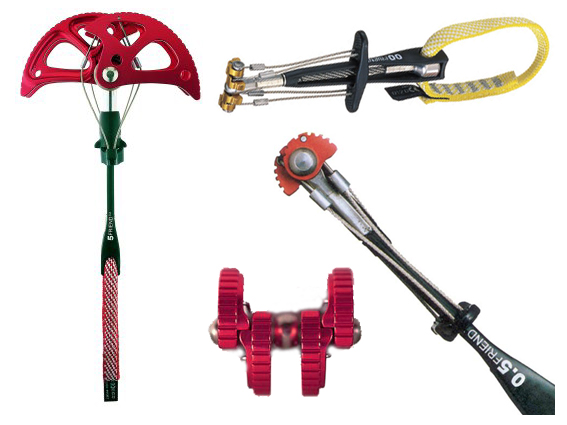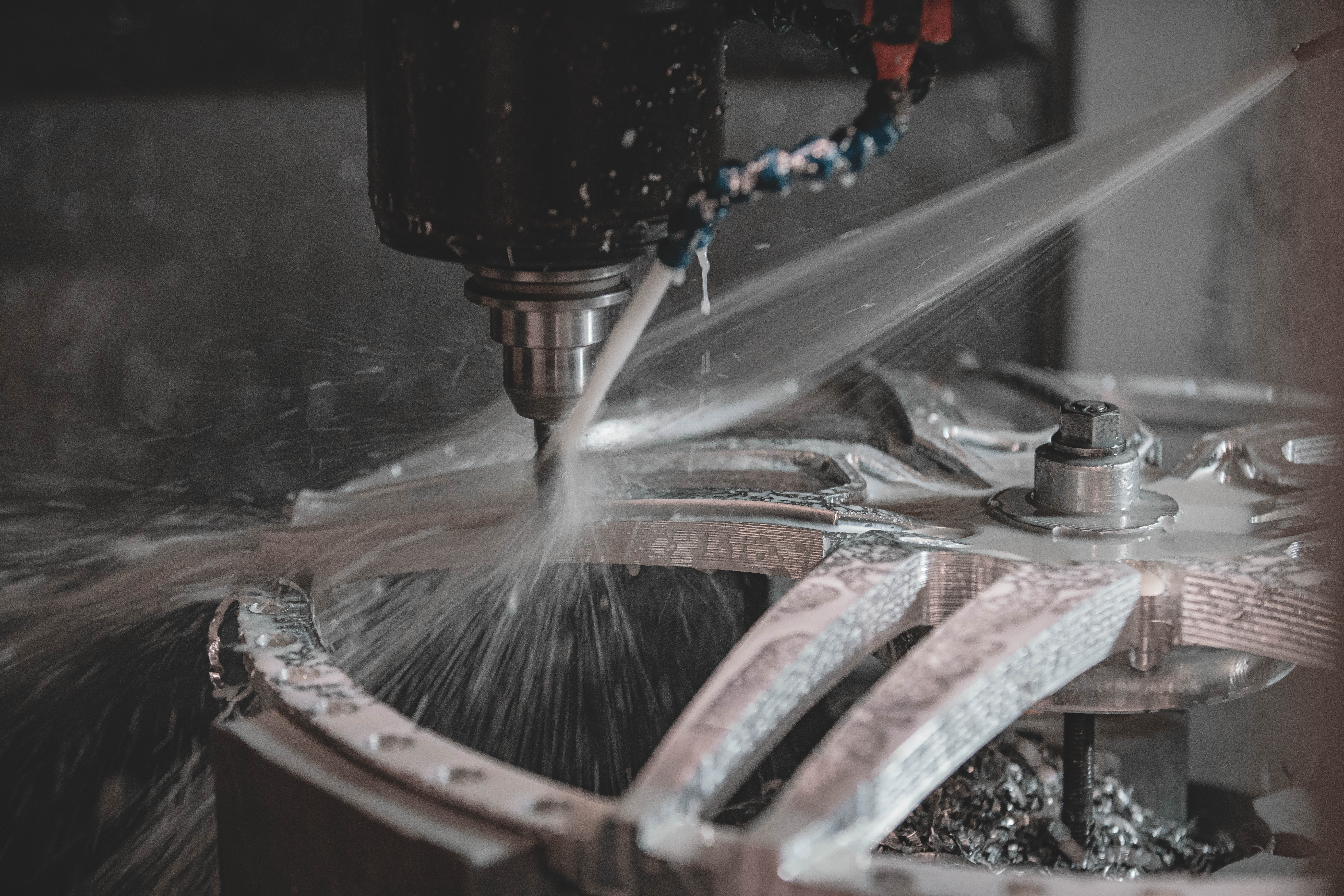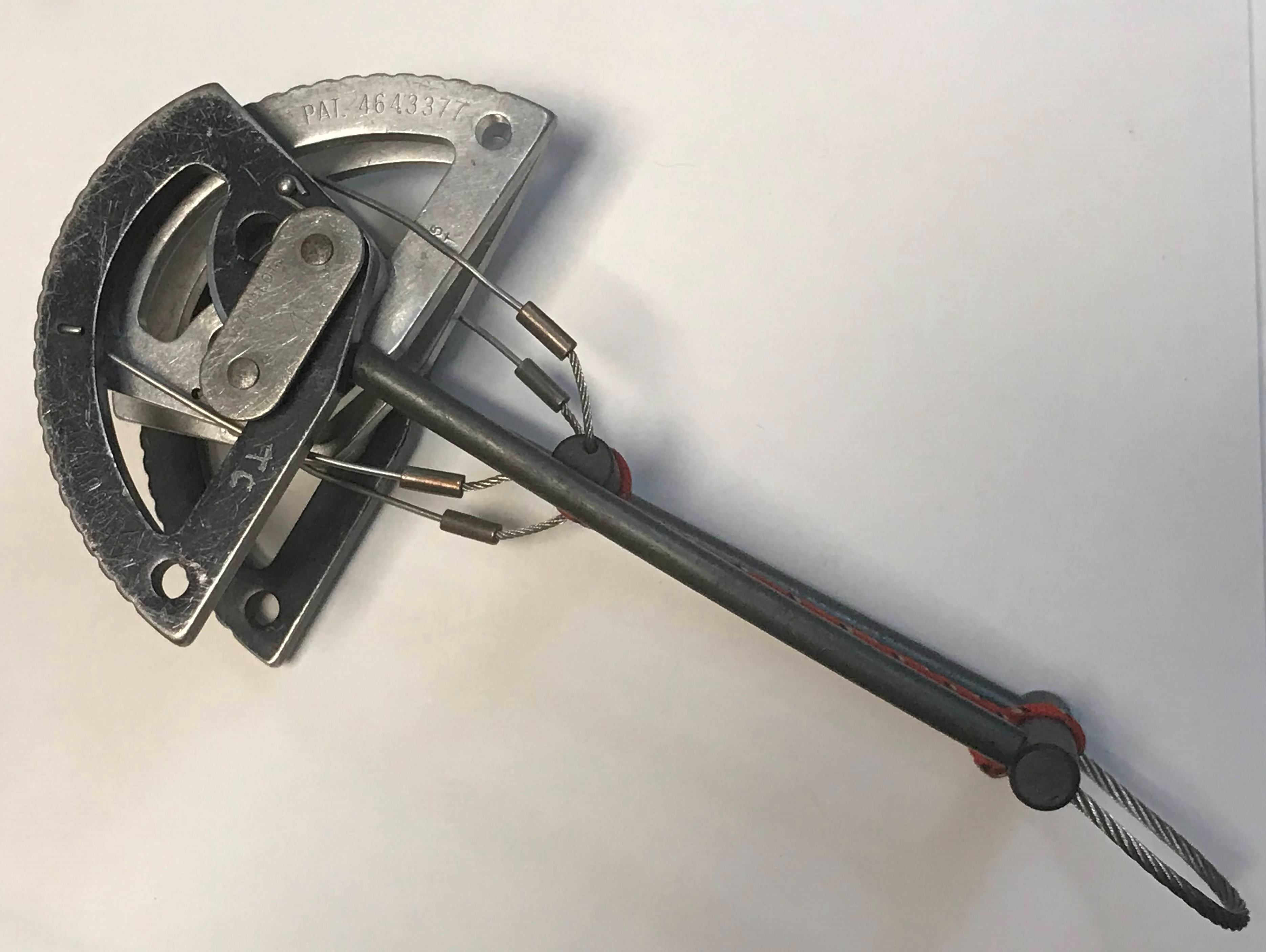|
Spring-loaded Camming Device
A spring-loaded camming device (also SLCD, cam or friend) is a piece of rock climbing or mountaineering protection equipment. It consists of two, three, or four cams mounted on a common axle or two adjacent axles, so that pulling on the axle forces the cams to spread further apart. It is then attached to a sling and carabiner at the end of the stem. The SLCD is used by pulling on the "trigger" (a small handle) so that the cams retract together, then inserting it into a crack or pocket in the rock and releasing the trigger to allow the cams to expand. A pull on the rope, such as that generated by a climber falling, will cause a properly placed SLCD to convert the pulling force along the stem of the unit into outwards pressure on the rock, producing massive amounts of friction and preventing the removal of the unit from the rock. Due to the large forces exerted on the rock when an SLCD is fallen on, it is very important that SLCDs are only placed in solid, strong rock. History V ... [...More Info...] [...Related Items...] OR: [Wikipedia] [Google] [Baidu] |
Klim Friends .
*
{{Disambiguation, callsign ...
Klim may refer to: * Klim (surname), a list of people and fictional characters * Klim (given name), a list of people and fictional characters * Klim (TV series), a Russian TV show * Klim (powdered milk), a powdered milk product * Klim (clothing), a clothing company * Klim, Denmark, a village * Klim Type Foundry * KCRN (AM), a radio station licensed to Limon, Colorado, United States, which held the call sign KLIM from 1984 to 2018 See also * ''Niels Klim's Underground Travels'', a satirical science-fiction/fantasy novel written by the Norwegian–Danish author Ludvig Holberg Ludvig Holberg, Baron of Holberg (3 December 1684 – 28 January 1754) was a writer, essayist, philosopher, historian and playwright born in Bergen, Norway, during the time of the Denmark–Norway, Dano–Norwegian dual monarchy. He was infl ... [...More Info...] [...Related Items...] OR: [Wikipedia] [Google] [Baidu] |
Mark Vallance
Mark Vallance (1946 – 19 April 2018) was a British rock climber, mountaineer and founder of Wild Country, a climbing equipment company. Founder of Wild Country He was instrumental in the design and development of a range of new equipment. American climber Ray Jardine, a climbing partner, had developed the first SLCD which were called "friends" by Yosemite climbers who had seen Jardine's climbs. Vallance took out a second mortgage on his house around 1977 so that he and Ray could produce "friends". A particularly successful design was a spring-loaded camming device branded the 'Friend'. It was revolutionary as a form of climbing protection, enabling climbers to tackle routes involving parallel or flared cracks in relative safety. Mountaineering career Vallance was a member of numerous Himalayan climbing expeditions, including one to Broad Peak. Wider climbing roles Vallance was co-founder and part of the build team of the Foundry Climbing Wall in Sheffield—the firs ... [...More Info...] [...Related Items...] OR: [Wikipedia] [Google] [Baidu] |
Soviet Inventions
This timeline of Russian innovation encompasses key events in the history of technology in Russia. The entries in this timeline fall into the following categories: * indigenous invention, like airliners, AC transformers, radio receivers, television, artificial satellites, ICBMs * uniquely Russian products, objects and events, like Saint Basil's Cathedral, Matryoshka dolls, Russian vodka * products and objects with superlative characteristics, like the Tsar Bomba, the AK-47, and the Typhoon-class submarine * scientific and medical discoveries, like the periodic law, vitamins and stem cells This timeline includes scientific and medical discoveries, products and technologies introduced by various peoples of Russia and its predecessor states, regardless of ethnicity, and also lists inventions by naturalized immigrant citizens. Certain innovations achieved internationally may also appear in this timeline in cases where the Russian side played a major role in such projects. ... [...More Info...] [...Related Items...] OR: [Wikipedia] [Google] [Baidu] |
Mountaineering Equipment
Rock-climbing equipment varies with the specific type of climbing that is undertaken. Bouldering needs the least equipment outside of climbing shoes, climbing chalk and optional crash pads. Sport climbing adds ropes, harnesses, belay devices, and quickdraws to clip into pre-drilled bolts. Traditional climbing adds the need to carry a "rack" of temporary passive and active protection devices. Multi-pitch climbing, and the related big wall climbing, adds devices to assist in ascending and descending fixed ropes. Finally, aid climbing uses unique equipment to give mechanical assistance to the climber in their upward movement (e.g. aiders). Advances in equipment are a key part of the rock climbing history, starting with the climbing rope. Modern devices enable climbers to perform tasks previously done manually, with greater control – in all conditions – and with less effort. Examples of replacements include the harness (replaced tying the rope around the waist), t ... [...More Info...] [...Related Items...] OR: [Wikipedia] [Google] [Baidu] |
Indian Creek (climbing Area)
Indian Creek is a climbing area in the northern part of the Bears Ears National Monument in the canyonlands area of San Juan County, Utah, United States. that is renowned for its sandstone crack climbing. It has an elevation of . Gallery File:Coyne Crack 5.11+ - Supercrack Buttress - Indian Creek.jpg File:Crack climbing in Indian Creek, Utah.jpg File:Creeks Giving - Climbing in Indian Creek, Utah - 10.jpg File:Creeks Giving - Climbing in Indian Creek, Utah - 14.jpg File:Creeks Giving - Climbing in Indian Creek, Utah - 28.jpg File:Creeks Giving - Climbing in Indian Creek, Utah - 9.jpg File:Climbing at Indian Creek (BLM area) (9737689570).jpg See also * Bridger Jack Butte * Sixshooter Peaks The Sixshooter Peaks are two iconic sandstone summits located in Bears Ears National Monument in San Juan County, Utah, United States. The larger and higher North Sixshooter Peak rises to an elevation of , whereas South Sixshooter Peak rises t ... References External links * Cl ... [...More Info...] [...Related Items...] OR: [Wikipedia] [Google] [Baidu] |
Traditional Climbing
Traditional climbing (or trad climbing) is a type of free climbing in rock climbing where the lead climber places removable protection while simultaneously ascending the route; when the lead climber has completed the route, the second climber (or belayer) then removes this protection as they ascend the route. Traditional climbing differs from sport climbing where the protection equipment is already pre-drilled into the rock in the form of bolts. Traditional climbing is still the dominant format on longer multi-pitch routes, including alpine and big wall. Traditional climbing carries a much higher level of risk than bolted sport climbing as the climber may not have placed the protection equipment correctly while ascending the route, or there may be few opportunities to insert satisfactory protection (e.g. on very difficult routes). Traditional climbing was once the dominant form of free climbing but since the mid-1980s, sport climbing — and its related form of competition ... [...More Info...] [...Related Items...] OR: [Wikipedia] [Google] [Baidu] |
Stainless-steel
Stainless steel, also known as inox, corrosion-resistant steel (CRES), or rustless steel, is an iron-based alloy that contains chromium, making it resistant to rust and corrosion. Stainless steel's resistance to corrosion comes from its chromium content of 11% or more, which forms a passive film that protects the material and can self-heal when exposed to oxygen. It can be further alloyed with elements like molybdenum, carbon, nickel and nitrogen to enhance specific properties for various applications. The alloy's properties, such as luster and resistance to corrosion, are useful in many applications. Stainless steel can be rolled into sheets, plates, bars, wire, and tubing. These can be used in cookware, cutlery, surgical instruments, major appliances, vehicles, construction material in large buildings, industrial equipment (e.g., in paper mills, chemical plants, water treatment), and storage tanks and tankers for chemicals and food products. Some grades are also s ... [...More Info...] [...Related Items...] OR: [Wikipedia] [Google] [Baidu] |
Brazing
Brazing is a metal-joining process in which two or more metal items are joined by melting and flowing a filler metal into the joint, with the filler metal having a lower melting point than the adjoining metal. Brazing differs from welding in that it does not involve melting the work pieces. Brazing differs from soldering through the use of a higher temperature and much more closely fitted parts. During the brazing process, the filler metal flows into the gap between close-fitting parts by capillary action. The filler metal is brought slightly above its melting ( liquidus) temperature while protected by a suitable atmosphere, usually a flux. It then flows over the base metal (in a process known as wetting) and is then cooled to join the work pieces together. Brazing joins the same or different metals with considerable strength. Process Brazing has many advantages over other metal-joining techniques, such as welding. Since brazing does not melt the base metal of the joi ... [...More Info...] [...Related Items...] OR: [Wikipedia] [Google] [Baidu] |
Machining
Machining is a manufacturing process where a desired shape or part is created using the controlled removal of material, most often metal, from a larger piece of raw material by cutting. Machining is a form of subtractive manufacturing, which utilizes machine tools, in contrast to ''additive manufacturing'' (e.g. 3D printing processes, 3D printing), which uses controlled addition of material. Machining is a major process of the manufacture of many metal products, but it can also be used on other materials such as wood, plastic, ceramic, and composite material, composites. A person who specializes in machining is called a machinist. As a commercial venture, machining is generally performed in a machine shop, which consists of one or more workrooms containing primary machine tools. Although a machine shop can be a standalone operation, many businesses maintain internal machine shops or tool rooms that support their specialized needs. Much modern-day machining uses Numerical control, ... [...More Info...] [...Related Items...] OR: [Wikipedia] [Google] [Baidu] |
Clean Climbing
Clean climbing is rock climbing techniques and equipment which climbers use in order to avoid damage to the rock. These techniques date at least in part from the 1920s and earlier in England, but the term itself may have emerged in about 1970 during the widespread and rapid adoption in the United States and Canada of nuts (also called chocks), and the very similar but often larger hexes, in preference to pitons, which damage rock and are more difficult and time-consuming to install. Pitons were thus eliminated in North America as a primary means of climbing protection in a period of less than three years. Due to major improvements in equipment and technique, the term ''clean climbing'' has come to occupy a far less central, and somewhat different, position in discussions of climbing technology, compared with that of the brief and formative period when it emerged four decades ago. Rock preservation Drilled and hammered equipment such as bolts, pitons, copperheads and others sca ... [...More Info...] [...Related Items...] OR: [Wikipedia] [Google] [Baidu] |
Piton
A piton (; also called ''pin'' or ''peg'') in big wall climbing and in aid climbing is a metal spike (usually steel) that is driven into a crack or seam in the climbing surface using a Rock climbing hammer, climbing hammer, and which acts as an anchor for protection (climbing), protecting the climber from falling or to assist progress in aid climbing. Pitons are equipped with an eye hole or a ring to which a carabiner is attached; the carabiner can then be directly or indirectly connected to a climbing rope. Pitons were the original form of protection (climbing), protection and are still used where there is no alternative. Repeated hammering and extraction of pitons damage the rock, and climbers who subscribe to the clean climbing ethic avoid their use as much as possible. With the popularization of clean climbing in the 1970s, pitons were largely replaced by faster and easier-to-use clean protection, such as nut (climbing), nuts and spring-loaded camming device, camming devi ... [...More Info...] [...Related Items...] OR: [Wikipedia] [Google] [Baidu] |
Camalot Number 6
Camalot is a brand of spring-loaded camming devices manufactured by Black Diamond Equipment used to secure ropes while rock climbing. Camalots use a dual-axle system, resulting in a slightly higher expansion range than similarly sized single axle units, however that results in significant weight penalty. Dual-axle was patented and for decades was only used by Black Diamond, however the patent has expired in 2005 and several other manufacturers began producing dual-axel cams, often also replicating Camalots sizes and coloring. Most notable Camalot look-alikes include DMM Dragons and Wild Country (company), Wild Country's New Friends. Like other spring-loaded camming device, cams, Camalot lobes are in the shape of a logarithmic spiral, resulting in a constant angle between the cam and the rock at each contact point; this constant angle is designed to always provide the necessary friction to hold a cam in equilibrium. Models Black Diamond has produced several different models of Cam ... [...More Info...] [...Related Items...] OR: [Wikipedia] [Google] [Baidu] |







